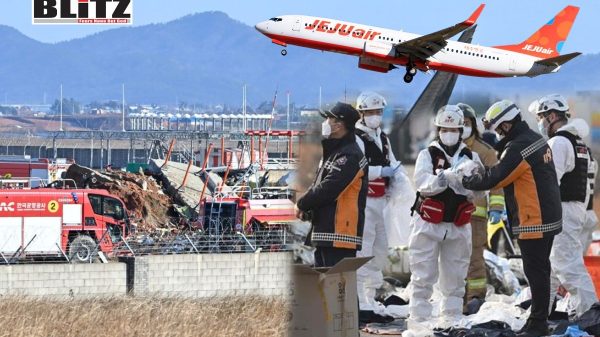Tragic Jeju Air Flight 2216 crash in South Korea claims 179 lives
- Update Time : Monday, December 30, 2024

In a devastating accident on Dec 29, Jeju Air Flight 2216 crashed while attempting to land at Muan International Airport in South Korea, leaving 179 people feared dead. This tragic incident has shaken the aviation industry and the nation, marking a dark chapter in South Korea’s aviation history.
Jeju Air Flight 2216 was a scheduled international passenger flight from Suvarnabhumi Airport near Bangkok, Thailand, to Muan International Airport in South Korea’s Muan County. The flight carried 175 passengers, predominantly South Korean nationals returning from holiday trips in Thailand, and six crew members.
The crash occurred around 9:00 am local time as the aircraft attempted to land in adverse weather conditions. According to reports, the landing gear malfunctioned, likely due to a bird strike, forcing the pilot to attempt a belly landing. Eyewitnesses described hearing loud bangs as the plane skidded along the runway, veered off course, and collided with the airport’s perimeter fence.
Disturbing footage shared on social media shows the Jeju Air Boeing 737-800 engulfed in flames, with thick plumes of black smoke billowing into the sky. The aircraft broke into two pieces upon impact, with only the tail assembly remaining recognizable amidst the wreckage. Rescue operations transitioned swiftly into recovery efforts as authorities struggled to identify the deceased.
Out of the 181 people on board, only two crew members survived the crash. Both individuals, including a 33-year-old flight attendant identified as Lee Mo, sustained moderate to severe injuries. Lee, who was seated at the back of the plane, reportedly remembers the plane touching down but has no recollection of events afterward. He was found in a state of shock and taken to a nearby hospital.
Rescue workers faced significant challenges in their efforts to locate and recover the bodies of the deceased. The chief of the Muan fire station, Lee Jeong-hyeon, stated that identifying the victims has been difficult due to the extensive damage caused by the fire. “The plane was completely destroyed, with only the tail assembly remaining recognizable among the wreckage,” he said during a televised briefing.
The incident prompted a swift response from South Korean authorities. Acting President Choi Sang-mok visited the crash site and declared Muan a special disaster zone. This designation activates emergency relief measures and financial support for the affected region and its residents.
Jeju Air, which had never experienced a fatal crash since its inception in 2005, issued a public apology. CEO Kim E-bae expressed profound regret and emphasized the company’s commitment to supporting the victims’ families. “Our first priority is to do everything possible to manage this incident,” Jeju Air stated on its website.
Preliminary investigations suggest a bird strike combined with adverse weather conditions may have led to the landing gear failure. Officials noted that the pilot attempted a standard “go-around” maneuver after the initial failed landing but was unable to stabilize the aircraft during the second attempt.
The plane’s inability to deploy its landing gear forced the pilot to attempt a belly landing, which proved catastrophic. The aircraft failed to slow down sufficiently, crashing into airport structures and igniting a massive fire. The investigation, led by South Korean aviation authorities, aims to determine the exact sequence of events that led to the tragedy.
This crash is the deadliest aviation accident involving a South Korean airline since 1997, when a Korean Air jet crashed into a hill in Guam, killing 229 of the 254 passengers on board. It also evokes memories of other significant aviation disasters in South Korea, including the 1993 Asiana Airlines crash in Mokpo, which claimed 68 lives, and the 2002 Air China crash near Gimhae Airport, which killed 129 people.
The Jeju Air crash has reignited concerns about aviation safety, particularly the risks associated with bird strikes and landing gear malfunctions. Bird strikes, though relatively rare, can cause significant damage to an aircraft, especially during critical phases of flight like takeoff and landing.
This tragedy comes just a week after another devastating aviation accident involving an Azerbaijan Airlines plane near Kazakhstan’s Aktau, which killed 38 of the 67 people on board. The back-to-back incidents have cast a somber shadow over the global aviation industry, highlighting the ever-present risks associated with air travel.
Many of the passengers on Jeju Air Flight 2216 were families returning from Christmas holidays in Thailand. The devastating loss of life has left a profound impact on their loved ones and the broader South Korean community. Images of grieving families and charred wreckage have dominated news broadcasts, serving as a stark reminder of the fragility of life.
As authorities work to recover and identify the victims, the emotional toll on the survivors, families, and rescue workers continues to mount. The tragedy has sparked an outpouring of grief and support from across the nation, with memorials and vigils held to honor the lives lost.
In the aftermath of the crash, South Korea faces the dual challenge of mourning its loss and ensuring that such incidents are prevented in the future. Aviation experts stress the need for rigorous safety measures, including improved bird detection systems and regular maintenance checks for landing gear mechanisms.
Jeju Air, for its part, has pledged full cooperation with the investigation and announced plans to enhance its safety protocols. The airline’s reputation, built over nearly two decades of incident-free operations, now faces significant scrutiny.
The crash of Jeju Air Flight 2216 is a harrowing reminder of the inherent risks of air travel and the devastating impact of aviation disasters. As South Korea grapples with this tragedy, the focus must remain on supporting the victims’ families, uncovering the root causes, and implementing measures to prevent future accidents.
While no words can undo the pain and loss suffered by the families of the 179 victims, the hope is that this tragedy will lead to meaningful changes in aviation safety, honoring the memory of those who perished.













Leave a Reply